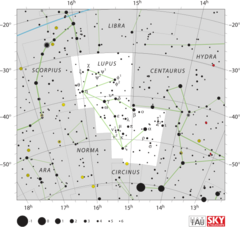Astronomy:Gamma Lupi
| Observation data Equinox J2000.0]] (ICRS) | |
|---|---|
| Constellation | Lupus |
| Right ascension | 15h 35m 08.44835s[1] |
| Declination | –41° 10′ 00.3247″[1] |
| Apparent magnitude (V) | 2.77[2] |
| Characteristics | |
| Spectral type | B2 IV[3] |
| U−B color index | –0.82[4] |
| B−V color index | –0.20[4] |
| Astrometry | |
| Radial velocity (Rv) | +2.3[5] km/s |
| Proper motion (μ) | RA: −15.62[1] mas/yr Dec.: −25.43[1] mas/yr |
| Parallax (π) | 7.75 ± 0.50[1] mas |
| Distance | 420 ± 30 ly (129 ± 8 pc) |
| Absolute magnitude (MV) | –2.4[2] |
| Orbit[6] | |
| Period (P) | 190.0 yr |
| Semi-major axis (a) | 0.655″ |
| Eccentricity (e) | 0.51 |
| Inclination (i) | 95.0° |
| Longitude of the node (Ω) | 94.6° |
| Periastron epoch (T) | 1885.0 |
| Argument of periastron (ω) (secondary) | 311.5° |
| Details | |
| γ Lup A | |
| Mass | 9.5±0.2[3] M☉ |
| Luminosity | 5,000[2] L☉ |
| Surface gravity (log g) | 3.96[2] cgs |
| Temperature | 20,900[2] K |
| Rotational velocity (v sin i) | 270[7] km/s |
| Age | 18.6±2.4[3] Myr |
| Other designations | |
| Database references | |
| SIMBAD | data |
Gamma Lupi, Latinized from γ Lupi, is a 3rd-magnitude, B-type blue giant star in the constellation of Lupus. It is also known in ancient Chinese astronomy as 騎官一 or "the 1st (star) of the Cavalry Officer". With a telescope, Gamma Lupi can be resolved into a binary star system in close orbit. This is known as the Gamma Lupi AB system, often abbreviated as γ Lupi AB or γ Lup AB.
Gamma Lupi A is itself a spectroscopic binary with a period of 2.849769 days.[10] Although the system does not show eclipses, the hotter star of the pair heats the side of the cooler star that faces it, and as they orbit each other the combined starlight varies in brightness by about 0.02 magnitudes, as seen from the Earth.[11]
This star is a proper motion member of the Upper Centaurus–Lupus sub-group in the Scorpius–Centaurus OB association, the nearest such co-moving association of massive stars to the Sun.[2]
See also
References
- ↑ 1.0 1.1 1.2 1.3 1.4 van Leeuwen, F. (November 2007), "Validation of the new Hipparcos reduction", Astronomy and Astrophysics 474 (2): 653–664, doi:10.1051/0004-6361:20078357, Bibcode: 2007A&A...474..653V
- ↑ 2.0 2.1 2.2 2.3 2.4 2.5 de Geus, E. J.; de Zeeuw, P. T.; Lub, J. (June 1989), "Physical parameters of stars in the Scorpio-Centaurus OB association", Astronomy and Astrophysics 216 (1–2): 44–61, Bibcode: 1989A&A...216...44D
- ↑ 3.0 3.1 3.2 Tetzlaff, N.; Neuhäuser, R.; Hohle, M. M. (January 2011), "A catalogue of young runaway Hipparcos stars within 3 kpc from the Sun", Monthly Notices of the Royal Astronomical Society 410 (1): 190–200, doi:10.1111/j.1365-2966.2010.17434.x, Bibcode: 2011MNRAS.410..190T
- ↑ 4.0 4.1 Johnson, H. L. et al. (1966), "UBVRIJKL photometry of the bright stars", Communications of the Lunar and Planetary Laboratory 4 (99): 99, Bibcode: 1966CoLPL...4...99J
- ↑ Evans, D. S. (June 20–24, 1966), Batten, Alan Henry; Heard, John Frederick, eds., "The Revision of the General Catalogue of Radial Velocities", Determination of Radial Velocities and their Applications, Proceedings from IAU Symposium no. 30 (University of Toronto: International Astronomical Union) 30: p. 57, Bibcode: 1967IAUS...30...57E
- ↑ Hartkopf, W. I.; Mason, B. D.; Worley, C. E., Sixth Catalog of Orbits of Visual Binary Stars, http://ad.usno.navy.mil/wds/orb6/orb6orbits.html#15351-4110, retrieved 2010-11-10
- ↑ Bernacca, P. L.; Perinotto, M. (1970), "A catalogue of stellar rotational velocities", Contributi Osservatorio Astronomico di Padova in Asiago 239 (1): 1, Bibcode: 1970CoAsi.239....1B
- ↑ "* gam Lup". SIMBAD. Centre de données astronomiques de Strasbourg. http://simbad.u-strasbg.fr/simbad/sim-basic?Ident=%2A+gam+Lup.
- ↑ "MAST: Barbara A. Mikulski Archive for Space Telescopes". Space Telescope Science Institute. https://mast.stsci.edu/portal/Mashup/Clients/Mast/Portal.html.
- ↑ Jerzykiewicz, M.; Pigulski, A.; Michalska, G.; Moździerski, D.; Ratajczak, M.; Handler, G.; Moffat, A. F. J.; Pablo, H. et al. (June 2021). "BRITE observations of ν Centauri and γ Lupi, the first non-eclipsing members of the new class of nascent binaries". Monthly Notices of the Royal Astronomical Society 503 (4): 5554–5568. doi:10.1093/mnras/stab846. Bibcode: 2021MNRAS.503.5554J. https://academic.oup.com/mnras/article/503/4/5554/6185045. Retrieved 16 December 2022.
- ↑ "gam Lup". AAVSO. https://www.aavso.org/vsx/index.php?view=detail.top&oid=17893.
 |



